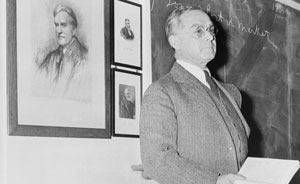talking history | syllabi | students | teachers | puzzle | about us
Virtual Museum & Archive of the SEC and Securities History
http://www.sechistorical.org
Created and maintained by the Securities and Exchange Commission Historical Society, Washington, D.C.
Reviewed April 1, 2006.
If, as many scholars have argued, federal regulatory agencies have a life cycle that begins with a promising birth, proceeds into aggressive adolescence, thence into a midlife crisis, and finally enters senility and decline, a similar trajectory may be found in this online museum and archive devoted to the history of the Securities and Exchange Commission (SEC). The Web site is independent of the SEC, but draws financial support from law firms that practice before the agency and entities subject to its jurisdiction.

Felix Frankfurther, who led the drafting of the Securities
Act of 1933 and was later named to the Supreme Court.
The museum and archive contains a timeline, papers, photos, oral histories, online programs, and links to other resources. The site begins by providing visitors with a solid documentary record of key legislative and administrative decisions, and it also supplements those public sources with photos and a broad sample of private correspondence from the SEC’s major actors in its formative years. The material in the archives that date closer to the present day, however, are predominantly readily available public sources, supplemented by several dozen oral histories and other materials (such as its employee newsletters) of interest only to the most avid followers of the agency’s life.
The New Deal sections are, not surprisingly, the richest on the site. They are highlighted by private correspondence drawn from collections at the Library of Congress, the National Archives, and the Franklin D. Roosevelt Library. Here one finds Ben Cohen informing James Landis about House passage of the 1933 Securities Act: “The debate was rather dry and much of it off the point, but the votes were there. When it was all over, [Sam] Rayburn remarked he did not know whether the bill passed so readily because it was damned good or so damn incomprehensible” (May 5, 1933, “Letter from Benjamin Cohen to James Landis”).
The more recent archival sections will sustain a visitor’s interest through a lively series of photographs and a useful collection of oral histories. By far the most engaging of the latter are the interviews with Stanley Sporkin, Milton Cohen, Irving Pollack, and David Ginsburg. The site also documents the transformation in gender relations that touched virtually all institutions in America, including the SEC, since the 1960s. Photographs from the 1940s and 1950s show all male SEC commissioners surrounded by female staff. But among the newest oral histories are those of past and present women SEC commissioners, notably Cynthia Glassman, Barbara Thomas Judge, Catherine McCoy, Lynn Turner, Mary Shapiro, and Annette Nazareth. Nazareth’s interview is especially revealing about how women lawyers and financial experts have followed their earlier male counterparts through the revolving door that leads from Wall Street to the SEC and often back again to Wall Street.
One looks in vain on the site, however, for any critical perspective on the SEC’s enforcement efforts during intense controversies such as those that plagued the chairmanship of William J. Casey, later of the Central Intelligence Agency (CIA) and architect of the Iran-Contra arms-for-hostages deal. At the SEC Casey became notorious for cutting sweetheart consent decrees with alleged financial miscreants such as the officials of the failed Franklin National Bank. And after leaving the agency, the former SEC chairman provided expensive legal advice to Glen Wu, one of the leading securities swindlers in the early 1970s.
The creators of the site are to be commended nonetheless for its fluid navigation, effective design, and superb integration of text and audio materials.
Michael E. Parrish
University of California, San Diego
La Jolla, California
